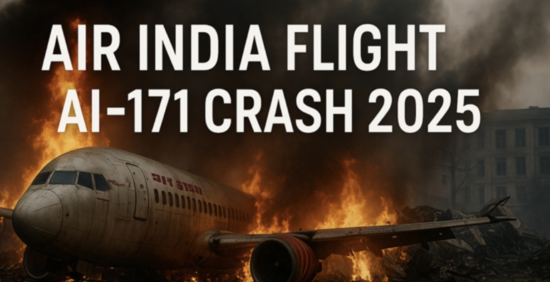On June 12, 2025, India witnessed its 2nd worst aviation disasters when Air India Flight AI-171, a Boeing 787-8 Dreamliner operating a scheduled service from Ahmedabad to London Gatwick, crashed just 36 seconds after takeoff from Sardar Vallabhbhai Patel International Airport. The aircraft was under the command of Captain Sumeet Sabharwal, a seasoned Line Training Captain with over 8,200 hours of flight experience, assisted by First Officer Clive Kunder, who had logged approximately 1,100 hours. At approximately 1:38 PM IST, shortly after becoming airborne, the aircraft lost altitude and plummeted into the BJ Medical College hostel complex in the densely populated Meghani Nagar area, erupting into a fireball and causing massive structural damage. All 241 people on board, including 14 crew members, perished in the crash, along with 19 individuals on the ground. The sole survivor, 27-year-old Vishwash Kumar Ramesh, a British national of Indian origin seated near an emergency exit, was thrown from the wreckage and is currently hospitalized in critical condition with multiple injuries. Investigators from the Aircraft Accident Investigation Bureau (AAIB), supported by international aviation experts, recovered both the Cockpit Voice Recorder (CVR) and Flight Data Recorder (FDR) within 28 hours. Preliminary analysis revealed that both engines lost thrust seconds after takeoff due to the fuel control switches being moved from RUN to CUTOFF, resulting in complete power failure. The CVR captured a brief distress call—“Mayday, mayday”—followed by the First Officer’s confused reaction and the Captain’s steady voice. In his final recorded message, Captain Sabharwal was heard saying, “Please, take care of papa. I will be back soon,” just before impact. Shockingly, the CVR stopped recording prior to the crash, suggesting a failure in the Recorder Independent Power Supply (RIPS), a system meant to preserve data even under catastrophic conditions. The cause of the fuel switch movement remains under investigation, with possibilities ranging from mechanical failure to inadvertent human error. A senior official from the investigation team stated, “We owe it to the victims and their families to ensure that no detail is overlooked. The truth must be found—not only for accountability but to prevent future tragedies.” This incident marks the first fatal crash involving a Boeing 787 globally and has triggered a comprehensive safety audit across India’s aviation sector. As the nation mourns, the legacy of this tragedy will undoubtedly lead to strengthened protocols, deeper oversight, and a renewed focus on aviation safety.



VERY NICE . The content is amazing . What a wonderful girl ! hats off !
Very useful Information !! Thanksss !!!